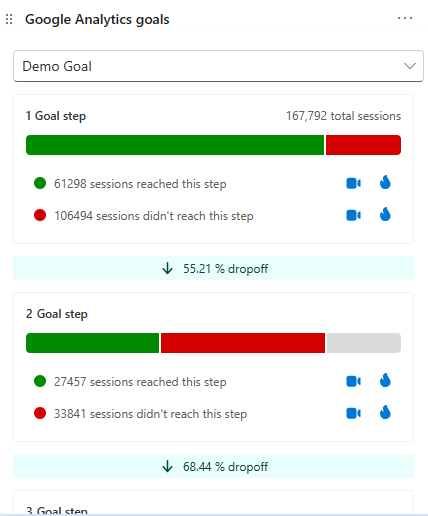Understanding What Data Is Google Analytics Goals Unable to Track
Discover the Limitations of Google Analytics Goals: Introducing the Data Types That Remain Untrackable
As businesses progressively count on data-driven decision-making, comprehending the restrictions of devices like Google Analytics ends up being vital. While Google Analytics Goals offer beneficial insights right into customer interactions, there exist information types that avoid monitoring, posing obstacles to an extensive understanding of individual habits. These untrackable information types elevate questions about the precision and efficiency of the analytics information that organizations heavily depend upon for their electronic strategies. Curious to reveal the covert dead spots in your data analysis procedure?
Insufficient Individual Trip Tracking
Incomplete customer journey tracking within Google Analytics can hinder the ability to properly examine individual habits. When the user journey is not completely tracked, there are voids in the information that stop an extensive understanding of exactly how customers engage with an internet site. This absence of understanding can cause missed chances for optimization and improvements to the user experience.
One common issue with insufficient customer trip monitoring is the failure to see the complete path that customers take in the past finishing an objective or leaving the website. Without this details, it is testing to recognize where customers might be running into challenges or rubbing factors that stop them from converting. In addition, insufficient monitoring can obscure the effect of specific marketing efforts or website modifications on user behavior.
To resolve this limitation, it is vital to establish proper monitoring systems within Google Analytics to capture the whole customer journey. This might include setting up occasion monitoring, goal funnels, or making use of tools like Google Tag Supervisor to make sure that no essential communications go unrecorded. By acquiring a comprehensive sight of the individual trip, web site owners can make even more educated choices to improve customer interaction and drive conversions.
Attribution Obstacles
Browsing with attribution difficulties in Google Analytics needs a detailed understanding of how various touchpoints add to the general conversion procedure. Attribution challenges arise from the intricacy of modern-day consumer trips, where customers connect with several channels prior to transforming. Google Analytics provides different attribution models like initial touch, last touch, and direct, each using a various perspective on exactly how credit score is assigned to touchpoints along the conversion course. These versions may not constantly precisely reflect the real influence of each touchpoint on the conversion.
One usual acknowledgment difficulty is the difficulty in attributing conversions to the appropriate resource, particularly in cases where individuals connect with numerous networks before transforming. In addition, cross-device monitoring poses another attribution difficulty, as users usually switch over in between tools throughout their trip, making it testing to track their interactions flawlessly.
Offline Conversions
Provided the challenges connected with connecting conversions properly in online networks, the measurement of offline conversions offers a considerable chance for marketing experts seeking an extra comprehensive understanding of their clients' journey. Offline conversions describe actions that clients absorb the real world, such as making purchases in brick-and-mortar stores or over the phone, participating in occasions, or engaging with printed products - what data is google analytics goals unable to track. These conversions are essential for services that run both online and offline, as they provide important understandings right into the performance of advertising and marketing campaigns throughout numerous touchpoints
Tracking offline conversions traditionally posed a substantial difficulty for marketing professionals, as it was challenging to connect these activities back to particular on-line interactions accurately. With innovations in technology, such as the assimilation of read this post here CRM systems, one-of-a-kind identifiers, and promo code codes, businesses can now bridge the void between online and offline information to acquire an extra alternative view of customer habits. By successfully gauging offline conversions, marketing experts can optimize their techniques, allot resources much more successfully, and eventually enhance the general consumer experience.
Cross-Device Tracking
Cross-device monitoring plays a vital role in comprehending the interconnected nature of consumers' electronic interactions throughout numerous gadgets. In today's omnichannel world, where individuals seamlessly switch over in between smart devices, tablets, and desktop computers, tracking their behavior throughout these devices is vital for online marketers to obtain a comprehensive view of their consumer trip.

Moreover, personal privacy issues and policies such as GDPR and CCPA have even more complex cross-device monitoring. With customers requiring even more control over their information and raised restrictions on tracking technologies, online marketers need to locate cutting-edge and privacy-compliant means to attach customer communications throughout gadgets.
Dynamic Material Interaction
Comprehending individual interaction with dynamic content is essential in enhancing digital advertising and marketing approaches for check it out boosted target market interaction. Dynamic content refers to internet site components that transform based upon individual habits, preferences, or other elements, offering an individualized experience. Tracking customer interactions with dynamic content postures challenges for conventional analytics tools like Google Analytics.
While Google Analytics can track basic communications like clicks and web page sights, it might struggle to record more nuanced interactions within dynamic content. what data is google analytics goals unable to track. Metrics such as time invested on particular vibrant aspects, hover actions, or communications within pop-ups are usually not quickly measurable utilizing basic monitoring methods. This constraint hinders online marketers' capacity to completely grasp exactly how customers are engaging with vibrant content and customize their methods accordingly

Verdict
Finally, Google Analytics goals have limitations in tracking incomplete individual trips, connecting conversions accurately, catching offline conversions, tracking cross-device interactions, and gauging dynamic content engagement. These restrictions highlight the value of discovering added monitoring see this here approaches and devices to obtain an extra thorough understanding of customer actions and conversions past what Google Analytics can provide.
While Google Analytics Goals offer important insights into user interactions, there exist information kinds that thwart monitoring, posing challenges to a detailed understanding of individual actions.Insufficient customer trip monitoring within Google Analytics can prevent the ability to accurately analyze user actions. When the customer journey is not completely tracked, there are voids in the data that stop a thorough understanding of just how individuals communicate with a web site.One common concern with insufficient user trip monitoring is the failure to see the full course that customers take before completing an objective or leaving the site. By gaining a thorough sight of the user trip, web site owners can make even more informed choices to improve user interaction and drive conversions.